Visitors Experiences in Different Zoo Exhibits
Serap Yılmaz1 * , Tuğba Düzenli1 and Abdullah Çiğdem1
DOI: http://dx.doi.org/10.12944/CWE.12.1.03
Zoos help people to learn through exhibiting the relationships of animals in nature. Therefore, they have the important missions of education and protection of wild life. Most of these missions are achieved through visitors' experiences in exhibit areas. Therefore, it is important to understand visitors' experiences in the zoo and know the reasons that affect these experiences. Animals should exhibit normal behaviors actively to enable visitors to have positive experiences during their visits. For this reason, the design of exhibit areas is significant.
The purpose of this study is to determine the visitors' perceptual descriptions in the zoos including different exhibit areas and their reasons to visit them. Thus, the role of the zoos in enabling visitors to learn nature protection and have environmental consciousness is explored correlating with zoo typologies.
In this study, three zoos in different typologies in Turkey have been examined and it is conducted in two stages. In the first stage, the typologies of the zoos have been identified. In the second stage, a questionnaire has been conducted to find out the visitors' visiting aims, the extent they reached these aims, their level of appreciation and their perceptions on exhibit areas. The questionnaire has been performed with 450 zoo visitors, and there have been 150 visitors from each zoo.
According to the results of this study, it has been explored that visitors visit the zoos mostly for "education" without considering the design approach. However, it has been found out that the design of exhibit areas affects visitors' level of appreciation and their zoo descriptions. It has been identified that as the level of appreciation increases, the level of reaching aims increases.
Copy the following to cite this article:
Yılmaz S, Düzenli T, ÇiÄŸdem A. Visitors Experiences in Different Zoo Exhibits. Curr World Environ 2017;12(1). DOI:http://dx.doi.org/10.12944/CWE.12.1.03
Copy the following to cite this URL:
Yılmaz S, Düzenli T, ÇiÄŸdem A. Visitors Experiences in Different Zoo Exhibits. Curr World Environ 2017;12(1). Available from: http://www.cwejournal.org/?p=16923
Download article (pdf) Citation Manager Publish History
Select type of program for download
| Endnote EndNote format (Mac & Win) | |
| Reference Manager Ris format (Win only) | |
| Procite Ris format (Win only) | |
| Medlars Format | |
| RefWorks Format RefWorks format (Mac & Win) | |
| BibTex Format BibTex format (Mac & Win) |
Article Publishing History
| Received: | 2017-02-15 |
|---|---|
| Accepted: | 2017-04-04 |
Introduction
Zoos are the places that enable human-animal interaction and they are visited by more than 700 million people annually1,2. Zoos, as places that help public to learn through reflecting the relationships of animals in nature3-8, have the important mission of educating and protecting wild life9. These missions can largely be achieved with the help of successful visitor experiences. Therefore, it is significant to understand visitor experiences in the zoo and to know the reasons that affect these experiences. During the visit, for visitors to have unique experience, animals should show normal behaviors in an active way2,10. The existence of active animals in the space positively affects the individuals' answers related to giving importance to animals and nature11-13. Otherwise, when the visitors see an animal lying instead of behaving naturally, their interest and perception to support zoos decrease significantly14. Within this context, it is very important for animals to exhibit their natural life in the exhibit areas, and this situation is related to the design of the exhibit areas. The more the exhibit area reflects the natural lives of animals and the more they provide opportunities for animals to live their natural lives, the more positively it affects the visitor experience because the design of exhibit areas are significant for visitors to learn, for them to behave positively to animals, for the duration they stay in exhibit areas, for their watching times and for examining and observing animal behaviors12, 15-19. The design of exhibit areas improves constantly to enrich the behavior and discipline of people in terms of protection and this improvement includes three generations:
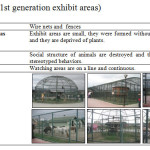 |
|
In 1st generation exhibits, a variety of animals are exhibited in cages and small areas20. This type of exhibits include data plates related to the animals21.
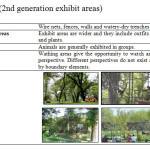 |
|
In 2nd generation exhibits, animals are exhibited in wide areas and these exhibits provide panoramic views to the visitors. In these exhibit areas, which have been developed by Carl Hagenbeck, the visibility of boundary elements is minimized; however, inorganic materals are still used in exhibit areas. In this method, it is not focued on the education of visitors, but on the view; visitors are able to see the animals without any obstruction with the help of ditches and railings below eye level21-25.
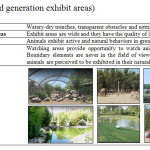 |
|
In 3rd generation exhibits, animals are exhibited with their own species in groups. Exhibit areas are designed including the topography and the types of plants in animals' natural environments and without including any boundary elements that distort the visual entegrity between animals and visitors15,22-24,26,27. Watching areas are outside the exhibit areas, which decreases the negative effect of crowds on animals and enable animals to exhibit more natural behaviors23. Therefore, animals are exhibited in a way that is suitable for their orginal habitats without destroying their social structure. This exhibiting method both involves visitors into natural world15,18,22,28, contributes to their learning and focuses on the benefits of animals15,22,29,30,31,32.
Table 4: T-test scores on the visitors’ level of achieving their zoo visiting aims
|
t |
df |
Sig. (2-tailed) |
Mean Difference |
95% Confidence Interval of the Difference |
||
|
Lower |
Upper |
|||||
|
Ä°zmir zoo |
53,514 |
149 |
,000 |
4,133 |
3,98 |
4,29 |
|
Ankara zoo |
22,423 |
149 |
,000 |
2,567 |
2,34 |
2,79 |
|
Samsun zoo |
23,785 |
149 |
,000 |
1,800 |
1,65 |
1,95 |
The design of exhibit areas is effective on the education of visitors in terms of protection, recogniziton and nature. Therefore, the aim of this study is to explore the effects of different kinds of exhibit methods on perceiving exhibit areas and on the purpose of visitors to visit the zoo. As a result, the role of zoos to raise awareness in nature protection.
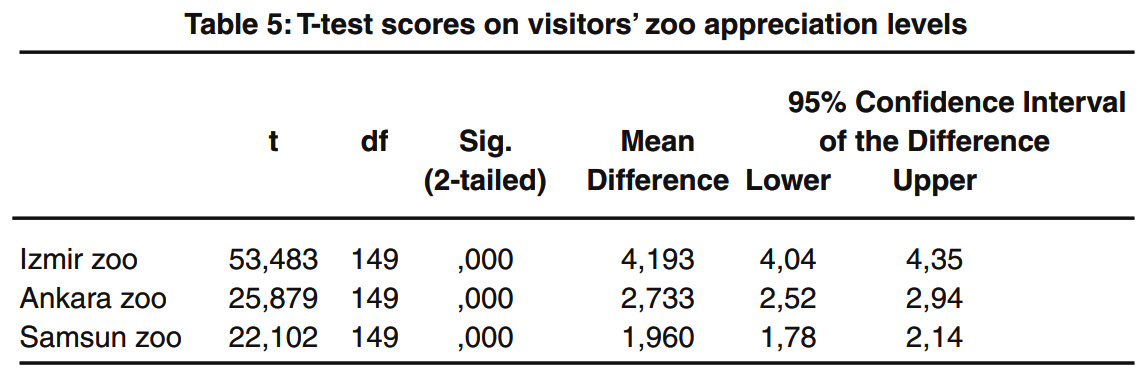 |
Table 5: T-test scores on visitors’ zoo appreciation levels Click here to view table |
The design of exhibit areas is effective on visitors' protection, recognition and nature education. Therefore, the purpose of this study is to determine the effects of different exhibiting methods on perceiving exhibit areas and visitors' zoo visiting aims. Therefore, the role of zoos to enable visitors to have nature protection and environmental consciencious is to be revealed through being related to zoo typologies.
Table 6: Data obtained from One way Anova
|
Sum of Squares |
df |
Mean Square |
F |
Sig. |
||
|
Natural |
Between Groups |
180,391 |
2 |
90,196 |
128,369 |
,000 |
|
Within Groups |
314,073 |
447 |
,703 |
|||
|
Total |
494,464 |
449 |
||||
|
Interesting |
Between Groups |
225,453 |
2 |
112,727 |
116,731 |
,000 |
|
Within Groups |
431,667 |
447 |
,966 |
|||
|
Total |
657,120 |
449 |
||||
|
Exciting |
Between Groups |
89,604 |
2 |
44,802 |
37,732 |
,000 |
|
Within Groups |
530,760 |
447 |
1,187 |
|||
|
Total |
620,364 |
449 |
||||
|
Impressive |
Between Groups |
88,458 |
2 |
44,229 |
35,779 |
,000 |
|
Within Groups |
552,573 |
447 |
1,236 |
|||
|
Total |
641,031 |
449 |
||||
|
Wide |
Between Groups |
224,338 |
2 |
112,169 |
133,758 |
,000 |
|
Within Groups |
374,853 |
447 |
,839 |
|||
|
Total |
599,191 |
449 |
||||
|
Bounded |
Between Groups |
441,938 |
2 |
220,969 |
278,229 |
,000 |
|
Within Groups |
355,007 |
447 |
,794 |
|||
|
Total |
796,944 |
449 |
||||
|
Attractive |
Between Groups |
192,858 |
2 |
96,429 |
102,607 |
,000 |
|
Within Groups |
420,087 |
447 |
,940 |
|||
Materıal and Method
Three zoos that include different exhibiting methods and that are located in different regions in Turkey are selected for this study:
- Samsun zoo (1st generation exhibit areas)
- Ankara zoo (2nd generation exhibit areas)
- Izmir zoo (3rd generation exhibit areas)
The study is formed in two stages: In the first stage, the typologies of the zoos are identified.In the second stage, a questionnaire was prepared in order to explore visitors' zoo visiting aims, to what extend they reached these aims, their level of zoo appreciation and their perceptions on exhibit areas The questionnaire was performed with 450 zoo visitors, there were 150 visitors from each zoo. The participants were selected from those who agreed to participate in the questionnaire.
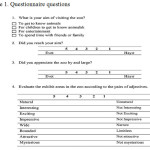 |
|
Four questions were asked in the questionnaire, and one of these questions was close-ended while the others were Likert attitude scale questions (Figure 1). Frequency analysis was made use of in analyzing the close-ended question. Also, χ2-test was used to determine if the results were statistically significant. In order to analyze the questions related to visitors' level of appreciation and their visiting aims, t-test from SPSS statistical software package was used and the differences among the zoos were revealed. The questions related to visitors' level of appreciation and their visiting aims were conducted using a 5-point Likert scale ranging from 1=strongly disagree to 5= strongly agree. The value that each question has according to 5-point Likert scale was determined through arithmetic mean, and the correlations among these questions were evaluated through correlation analysis (Pearson).
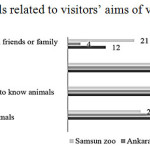 |
|
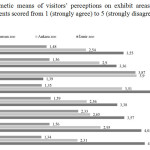 |
|
In the last question, visitors' perceptions on exhibit areas were evaluated and this evaluation was done through 5-point Likert attitude scale including pairs of adjectives. Through this method, it is possible to evaluate visitors' visual perceptions on exhibit areas. According to this scale, the answers including different adjectives were expressed through values 1-5. Data belonging to the adjectives that define exhibits in different zoos were evaluated by the help of “One-way Anova” analysis from SPSS statistical software package. The mean value of analyzed adjectives defining the situations of exhibits in the zoos were calculated. It was examined if the differences in averages were statistically significant, the differences between the exhibition generations’ in zoos were presented.
Results
1st Stage: Typologies of Zoos
In the first stage, the typologies of the zoos are identified (Table 1, 2, 3).
2nd Stage: Results
Results are presented in two sections. In the first section, visitors’ zoo appreciation levels, their visiting aims and the level of reaching these aims are found out. In the second section, the adjectives that generally describe the exhibit areas in these three zoos are identified and arithmetic means of the scores those adjectives received are calculated. Moreover, in this section, the differences between the perceptions on exhibit areas in these zoos including different types of exhibiting methods are also identified.
Determining the aims of visitors to visit the zoos
The frequencies related to visitors’ aims of visiting the zoos have been evaluated for the three zoos (Figure 2). The results showed that, visitors stated that they visit Izmir zoo for children to get to know animals, for entertainment and to get to know animals (χ2= 33.733, 3df, p < 0.01); they visit Ankara zoo for entertainment, for children to get to know animals and to get to know animals (χ2= 53.573, 3df, p < 0.01); they visit Samsun zoo for children to get to know animals for entertainment and to get to know animals (χ2= 29.093, 3df, p < 0.01)
Determining the visitors’ achieving their aim of visiting the zoos
Arithmetic means on the visitors’ level of achieving their aim are evaluated. According to these values, visitors achieved their visiting aims in Izmir zoo the most (4.13), in Ankara zoo in moderate levels (2.47), and in Samsun zoo the least (1.8). It is illustrated in Table 4 that the difference between these zoos is statistically significant.
Determining visitors’ zoo appreciation levels
Arithmetic means on visitors’ zoo appreciation levels are evaluated. According to these values, it is seen that the most appreciated zoo is Izmir zoo (4.19), moderately appreciated zoo is Ankara zoo (2.73) and the least appreciated zoo is Samsun zoo (1.96). In Table 5, it is indicated that the difference between the visitors’ appreciation levels in these zoos is statistically significant.
Determining the relationship between the level of visitors’ appreciation of the zoos and their achieving their aim of visiting the zoos
In order to obtain the data related to the level of visitors’ appreciation of the zoos and the level of achieving their aim, the data is analyzed through Pearson Correlation. When the results are analyzed, it is seen that in Izmir zoo, there is a very high, positive and significant correlation between the visitors’ appreciation levels of the zoos and the level of achieving their aim (r=0.961**; p<0.01). It is found out that in Ankara zoo, there is a high, positive and significant correlation between the visitors’ appreciation levels of the zoos and the level of achieving their aim (r=0.868**; p<0.01). It revealed that in Samsun zoo, there is a moderate, positive and significant correlation between the visitors’ appreciation levels of the zoos and the level of achieving their aim (r=0.485**; p<0.01).
Determining the values related to the perceptions of visitors on exhibit areas in the zoos
In this part, it is aimed to reveal how visitors generally perceive exhibit areas in these zoos that include three different exhibits. Therefore, exhibit areas in the zoos have been evaluated by the visitors through 8 pairs of adjectives. At the end of the evaluation, arithmetical averages related to the values of the pairs of adjectives in each zoo have been assessed, and the relationships between the variables related to perceptual descriptions of exhibit areas that include different features in the zoos have been analyzed through One -Way Anova.
As a result of One-Way Anova analysis, it has been found that the values of pairs of adjectives that describe each zoo are different from one another. It has been also revealed that these values show difference in sum total including these three zoos (p < 0.01, N= 150). The data gathered through Anova analysis are illustrated in Table 6.
The perceptions of the visitors on the zoos indicate differences according to the scores of the pairs of the adjectives.
Izmir Zoo including 3rd Generation exhibit areas had the highest scores in terms of perceptual descriptions of the visitors. The adjectives that had the highest scores in describing the zoo are as follows: natural (4.12), wide (4.31), interesting (4.03) while the adjective bounded (1.39) had the lowest score.
Ankara Zoo including 2nd generation exhibit areas had moderate values. The highest scores describing the zoo are as follows: bounded (3.9), wide (3.51), interesting (2.93) and impressive (2.9). The adjective natural (2.31) had the lowest score.
It was found out that Samsun Zoo including 1st generation exhibit areas had lowest values. The highest scores describing the zoo are as follows: bounded (3.87), wide (3.51) and exciting (2.93). The adjectives natural (1.34) and wide (1.35) had the lowest scores. Total scores that the pairs of adjectives received related to these evaluations have been illustrated in Figure 3.
Discussion
The purpose of this study is to reveal the evaluations of Turkish people on zoos including different generation exhibit areas, and to determine the effects of these zoos on visitors' visiting aims, their levels of reaching their aims and their perceptions.
The findings that suggest that the first aim of visitors is "education" and the second is "entertainment" indicate similarity with the findings in literature8,12,33-37. However, this study is different from other studies in that it suggests that no matter what the design approach is (1st generation or 3rd generation), visitors' visiting aims stay the same (education and entertainment). Moreover, it is found out that the difference in exhibiting animals extremely affects the visitors' level of appreciation and their level of reaching their aims. These findings indicate that in the 1st generation exhibit areas, the visitors' level of appreciation and their level of reaching their aims are quite low. This design approach is not adequate to meet the needs of animals; therefore, it destroys its own image for visitors. In the zoos, it is seen that as the exhibiting conditions become more natural (2nd and 3rd generation exhibit areas), visitors' level of appreciation and their level of reaching their aims increase. Especially in the zoo including 3rd generation exhibit areas (Natural exhibit areas), visitors' level of appreciation and their level of reaching their aims are the highest. This shows that statistically, there is a direct proportional, strong correlation between visitors' appreciating exhibit areas and their reaching their aims.
The increase in the level of naturalness in exhibit areas increases the visitors’ appreciation level, thus increasing their education experience. This enables people who have dilemmas about whether zoos are for “education” to be persuaded and visit the zoos more often. As a result, people become more interested in natural life and their attention is raised and it becomes easier for them to obtain information about animals because studies show that the attitudes and the knowledge of the visitors change after the zoo visit20,38. The design of exhibit areas are effective for this change to be positive or negative because while natural exhibit areas positively affect the attitudes of individuals towards animals and their learning8,18,28,32,35,39, unnatural exhibit areas affect them negatively12,25,31,35.
Findings indicate that different exhibit areas in zoos extremely influence visitors’ descriptions of those areas:
- Samsun zoo including 1st generation exhibit areas was described as exciting, mysterious, not natural, bounded and narrow.
- Ankara zoo including 2nd generation exhibit areas was described as interesting, impressive, bounded and not natural.
- Izmir zoo including 3rd generation exhibit areas was described as interesting, wide, not bounded and natural.
These descriptions indicate that no matter what the design conditions of the zoos are, they are described by the visitors through positive adjectives such as “exciting, mysterious, interesting and impressive”. According to these findings, without getting affected by the conditions animals are exhibited, visitors perceive animals as living creatures that are to be discovered. However, it is revealed in the study that the undesired conditions in exhibit areas such as the boundary elements that are seen clearly, scarcity of plants, narrowness of exhibit areas, not using the natural effect formed by water and topography cause zoos to be described by visitors through negative adjectives such as “unnatural, bounded and narrow.
Visitors’ describing zoos as “unnatural” destroys the perception that animals are a part of wild life; their describing zoos as “bounded and narrow” gives harm both to the idea that animals in zoos are free and the image that zoos are the living areas of animals. These negative perceptional descriptions caused by 1st and 2nd generation exhibit areas also negatively affects the learning experience in zoos because learning in zoos is related to the designed areas and their reflecting their aims well and this is a kind of learning in that perceptual data have a great role40. Therefore, it is important for visitors to obtain exact perceptual data from the environment because perceptual data cause individuals to change their ideas in their experiences41. Perceptual data obtained from zoo experience are very important in that they shape the zoo image in individuals’ minds.
The design of exhibit areas is of great importance for the zoo visit that the most of the visitors do for “educational purposes” to reach its aim. When the general perspective formed by these exhibit areas is perceived positively (such as natural, wide and limitless) by the visitors, zoos are provided to be perceived as learning environments as in a zoo including natural exhibit areas because these exhibit areas generally are the environments that aim to create "a beautiful and independent wildlife image living in a landscape that cannot be interfered by the human beings"20,42. This finding may as well be supported by the idea that was asserted by Carr and Cohen (2011) 43 suggesting that zoos may become the environments that promote learning by providing learning opportunities to the visitors and therefore, the role that they have as effective learning environments should not be disregarded.
As a result, the exhibiting conditions that prevent visitors to reach their aims in zoos and that destroy the image of zoo in the eyes of visitors are to be improved. Therefore, exhibit areas that describe animals' natural habitats well enable visitors to adopt the idea that natural life and animals are inseparable parts of the earth. One of the best places that may teach this discipline to the individuals is zoos. Zoo experiences positively affect individuals' awareness towards nature and animals.11-13,39
Conclusion
Zoos are the places that are observed and perceived by people, and they also include educational messages. Zoos are to be the environments where visitors obtain information about animals' lives and where they discover the interestingness of animal behaviors in natural exhibit areas. When zoos are designed well as places that are education-oriented and where people learn while they are entertaining, they influence visitors positively. However, when animals are not exhibited in a concept which is suitable for their actual environments, neither designers nor educationalists should expect visitors to learn in zoos because these badly-designed "ugly environments" cause people to have fear and indifference towards animals. Therefore, it is possible to attract visitors' attention to zoos merely through successful exhibit areas. The results of this study also have similar data:
- No matter what the zoo design approach is, visitors visit the zoos primarily for "education".
- Natural exhibit areas enable visitors to reach their aims; however, unnatural exhibit areas cause them not to reach their aims.
- Natural exhibit areas increase visitors' level of appreciation and they enable zoos to be described through positive qualities.
- Unnatural exhibit areas decrease visitors' level of appreciation and they cause zoos to be described through negative qualities. It is believed that this will negatively affect the ideas of visitors about animals and their qualities in the eyes of them such as being gorgeous, impressive, free and a part of wild nature.
- As visitors' level of appreciation increases, their level of reaching their aims increases.​​​​​​​
References
​​​​​​​
- Gusset M, Dick G. The Global Reach of Zoos and Aquariums in Visitor Numbers and Conservation Expenditures. Zoo Biology, 30:566-569 (2011)
CrossRef - Kirchgessner ML, Sewall BJ. The Impact of Environmental, Social, and Animal Factors on Visitor Stay Times at Big Cat Exhibits. Visitor Studies, 18(2):150-167, (2015)
CrossRef - Dierking LD, Falk JH. Family Behaviour and Learning in Ä°nformal Science Settings: A Review of The Research. Science Education, 78(1):57-72, (1994)
CrossRef - Swanagan JS. Factors Influencing Zoo Visitors’ Conservation Attitudes and Behavior. The Journal of Environmental Education, 31:26-31,( 2000)
CrossRef - Lukas KE, Ross SR. Zoo visitor knowledge and attitudes towards gorillas and chimpanzees. The Journal of Environmental Education, 36(4):33-48, (2005)CrossRef
- Ballantyne R, Packer J, Hughes K, et al. Conservation Learning in Wildlife Tourism Settings: Lessons from Research in Zoos and Aquariums. Environmental Education Research, 13:367-383, (2007)
CrossRef - Smith L, Broad S. Do Zoo Visitors Attend to Conservation Messages? A Case Study of an Elephant Exhibit. Tourism Review International, 11:225-235, (2008)
CrossRef - Carr N. Ideal Animals and Animal Traits for Zoos: General Public Perspectives. Tourism Management, 57:37-44, (2016)
CrossRef - Patrick P, Matthews C, Ayers D, et al. Conservation and Education: Prominent Themes in Zoo Mission Statements. Journal of Environmental Education, 38(3):53-60, (2007)
CrossRef - Altman JD. Animal Activity and Visitor Learning at the Zoo. Anthrozoos, 11(1):12-21, (1998)
CrossRef - Myers OE, Saunders CD, Birjulin AA. Emotional Dimensions of Watching Zoo Animals: an Experience Sampling Study Building on Insights from Psychology. Curator, 47(3): 299-321, (2004)
CrossRef - Clayton, S, Fraser J, Saunders CD. Zoo Experiences: Conversations, Connections, and Concern for Animals. Zoo Biology, 28:377-397, (2008)
CrossRef - Luebke JF, Watter J, Packer J, et al. Zoo Visitors’ Affective Responses to Observing Animal Behaviors. Visitor Studies, 19(1): 60-76, (2016)
CrossRef - Miller LJ. Visitor Reaction to Pacing Behavior: Influence on the Perception of Animal Care and Interest in Supporting Zoological Institutions. Zoo Biology, 31: 242-248, (2012)
CrossRef - Shettel-Neuber J. Second and Third- Generation Zoo Exhibits: A Comparison of Visitor, Staff and Animal Responses. Environment and Behaviour, 22(4):252-273, (1988)
- Johnston J. Exogenous Factors and Visitors Behavior: A Regression Analysis of Exhibit Viewing Time. Environment and Behavior.1998;30(3):322-347.
CrossRef - Wood W. Interactions Among Environmental Enrichment, Viewing Crowds, and Zoo Chimpanzees (Pantroglodytes). Zoo Biology, 17:211-230, (1998)
CrossRef - Totfield S, Coll R, Vyle B, et al. Zoos as a Source of Free Choice Learning. Research in Science and Technological Education. 2003;21:67-99.
- Rıdgway SC, Lıvıngston M, Steven ES. Visitor Behavior in Zoo Exhibits with Underwater Viewing. Visitor Studies Today, 8(3):1-10, (2005)
- Lukas KE, Ross SR. Naturalistic Exhibits May be More Effective than Traditional Exhibits at Improving Zoo-Visitor Attitudes toward African Apes. Anthrozoos, 27(3):435-455, (2015)
- Patrick P, Tunnicliffe S. Zoo Talk. New York (NY): Springer, (2013). p. 137-138.
CrossRef - Hancocks D. A Different Nature: The Paradoxical World and Their Uncertain Future. Berkeley: University of California Press, (2001) p. 280.
- Moss A, Esson M, Francis D. Evaluation of a Third-Generation Zoo Exhibit in Relation to Visitor Behavior and Interpretation Use. Journal of Interpretation Research, 15(2):11-28, (2010)
- Yılmaz S, Özbilen A. Hayvanat Bahçeleri Tasarım Ä°lkeleri ve Tipolojileri, SDÜ Orman Fakültesi Dergisi, 12:47-56, (2011)
- Kawata K. Romancing the Celluloid Nature: A Review of American Zoo Exhibits, part I, Der Zoologische Garten, 80:239-253, (2011)
CrossRef - Coe J. American Zoo and Aquarium Association. One Hundred Years of Evolution in Great Ape Facilities in American Zoos. In Proceedings of The AZA 1995 Western Regional Conference in Denver, CO., Bethesda: MD.
- Ross S, Gillespie K. Influences of Visitor Behavior at a Modern Immersive Zoo Exhibit. Zoo Biology, 28:462-472, (2009)
CrossRef - Davey G. An Environmental Design Project at Beijing Zoo. International Zoo News, 52(2):80-88, (2005)
- Bacon JP, Hallet M. Exhibit Systems for Reptiles and Amphibians at the San Diego Zoo. International Zoo Yearbook, 21:14-21, (1981)
CrossRef - Reade RS, Waran NK. The Modern Zoo: How Do People Perceive Zoo Animals? Journal of Applied Animal Welfare Science, 47:109-118, (1996)
CrossRef - Woods B. Good Zoo/Bad Zoo: Visitor Experiences in Captive Settings. Anthrozoos, 15(4):343-360, (2002)
CrossRef - Davey, G. Relationships between Exhibit Naturalism, Animal Visibility and Visitor Interest in a Chinese Zoo. Applied Animal Behaviour Science, 96(1-2):93-102, (2006)
CrossRef - Ryan C, Saward J. The Zoo as Ecotourism Attraction – Visitor Reactions, Perceptions and Management Implications: The Case of Hamilton Zoo, New Zealand. Journal of Sustainable Tourism, 12(3):245-266, (2004)
CrossRef - Hyson, J. Education, entertainment, and institutional identity at the zoo. Curator, 47(3), 247-251, (2004)
CrossRef - Yılmaz S, Mumcu S, Özbilen A. Effects of Spatial Differences on Visitor Perceptions at Zoo Exhibits. Scientific Research and Essays, 5(16):2327-2340, (2010)
- Lee HS. Measurement of Visitors' Satisfaction with Public Zoos in Korea Using Importance-Performance Analysis. Tourism Managemen, 47:251-260, (2015)
CrossRef - Therkelsen A, Lottrup M. Being Together at the Zoo: Zoo Experiences among Families with Children. Leisure Studies, 34(3):354-371, (2015)
CrossRef - Nakamichi M. Assessing the Effects of New Primate Exhibits on Zoo Visitors' Attitudes and Perceptions by Using Three Different Assessment Methods. Anthrozoos, 20(2):155-165, (2007)
CrossRef - Hacker CE, Miller LJ. Zoo Visitor Perceptions, Attitudes, and Conservation Intent After Viewing African Elephants at the San Diego Zoo Safari Park. Zoo Biology, 35(4):355-361, (2016)
CrossRef - Ballantyne R, Packer J. Promoting Environmentally Sustainable Attitudes and Behaviour Through Free-choice Learning Experiences: What is the State of the Game? Environmental Education Research, 11(3):281-295, (2005)
CrossRef - Lewis M. The Emergence of Human Emotions. In: Lewis MD, Haviland Jones JM, Feldman Barrett L, editors. Handbook of emotions. New York: The Guilford Press; 2010, p. 304–319.
- Coe JC. Design and Perception: Making the Zoo Experience Real. Zoo Biology, 4(2):197-208, (1985)
CrossRef - Carr N, Cohen S. The Public Face of Zoos: Balancing Entertainment, Education, and Conservation. Anthrozoos, 24(2):175-189, (2011)
CrossRef







